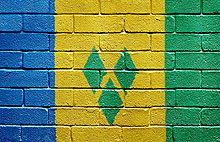Where Is Saint Vincent and What
Is It Known For?

Flag of Saint Vincent and the Grenadines painted onto a grunge brick wall.
|
Saint Vincent, whose territory includes islets and cays in the Grenadines, is in the Windward islands, in the Caribbean. It is the largest island of the chain called Saint Vincent and the Grenadines. This 389-square-kilometre (150 sq mi) territory consists of the main island of Saint Vincent and the northern two-thirds of the Grenadines, which are a chain of smaller islands stretching south from Saint Vincent Island to Grenada.
Beginning in 1719, French settlers gained control of the Saint Vincent and began cultivating coffee, tobacco, indigo, cotton, and sugar on plantations. These plantations were worked by enslaved Africans. In 1763, France ceded control of Saint Vincent to Britain. However, France re-invaded the island in 1779. The French regained control after landing at Calliaqua, near Fort Duvernette. The British then finally regained Saint Vincent under the Treaties of Versailles (1783). It gained independence on October 27, 1979.
The total population (July 2009 est.) is 104,574. Kingstown (population 19,300) is the chief town. The rest of the population is dispersed along the coastal strip, which includes the other five main towns of Layou, Barrouallie, Chateaubelair, Georgetown, and Calliaqua, and the Marriaqua Valley.
St Vincent itself is forested and mountainous, with an active volcano, Soufrière. The climate is tropical and wet. The economy is based mainly on agriculture and tourism. Bananas account for approximately one-third of export earnings and arrowroot is also important. Most trade is with the USA and other CARICOM countries.
|